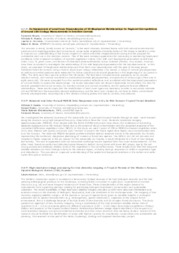An assessment of land cover dependencies of VI-biophysical relationships for regional extrapolations of ground LBA ecology measurements in Brazilian Cerrado.
An assessment of land cover dependencies of VI-biophysical relationships for regional extrapolations of ground LBA ecology measurements in Brazilian Cerrado.
Author(s): MIURA, T.; HUETE, A. R.; FERREIRA, L. G.; SANO, E. E.
Summary: The savanna in Brazil, locally known as “cerrado,” is the most intensely stressed biome with both natural environmental pressures and rapid/aggressive land conversions. Large-scale vegetation characterization of the biome is needed in order to improve our understanding of the human impact on carbon and other biogeochemical cycling and the prospect for sustainable land use in the Brazilian cerrado. One of the most common approaches for measuring or monitoring biophysical conditions is the empirical correlation of spectral vegetation indices (VIs) with such biophysical parameters as leaf area index (LAI), % green cover, and fraction of absorbed photosynthetically active radiation (fAPAR). Few studies, however, have been conducted to investigate the relationships of VIs with biophysical parameters for the Brazilian cerrado. In this study, we assessed VI-biophysical relationships and their land cover dependencies with the goal of deriving proper functional forms for cerrado using a hybrid, multi-layer canopy reflectance (CR) model. A range of cerrado physiognomies as well as converted pastures were measured for tissue optical and structural properties in the beginning of a dry period in 2002. The data were then used to contrain the CR model. The field sites included cerrado grassland, scrub cerrado, wooded cerrado, and cerrado woodland as undisturbed cerrado physiognomies, and pastures of various ages (from one to eight years old). VIs were computed from the model-simulated reflectance and correlated with the biophysical parameters of LAI and fAPAR to assess the relationships. The model-simulated data set showed observable trends where the data for cerrado grassland and scrub cerrado, for wooded cerrado and cerrado woodland, and for pastures formed different relationships. These results imply that the stratification of land cover types are necessary in order to accurately estimate LAI and fAPAR from the empirically-derived relationships, but the land cover classes do not have to follow conventional cerrado physiognomies, requiring only a few classes including grassy and woody cerrado, and pastures.
Publication year: 2004
Types of publication: Abstract in annals or event proceedings
Unit: Embrapa Cerrados
Keywords: Ecology, Land, Land cover, Savannas
Observation
Some of Embrapa's publications are published as ePub files. To read them, use or download one of the following free software options to your computer or mobile device. Android: Google Play Books; IOS: iBooks; Windows and Linux: Calibre.
Access other publications
Access the Agricultural Research Database (BDPA) to consult Embrapa's full library collection and records.
Visit Embrapa Bookstore to purchase books and other publications sold by Embrapa.

